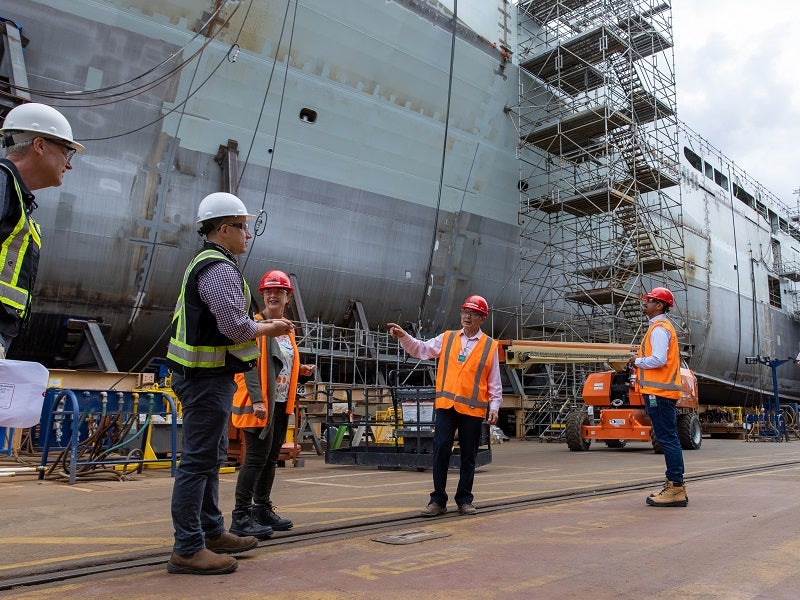The Protecteur-class Joint Support Ships (JSS) are a new class of two multi-role ships being built by Seaspan’s Vancouver Shipyards for the Royal Canadian Navy (RCN).
The new ships will increase the range and endurance of naval task group missions by providing replenishment at sea (RAS) capabilities, as well as serve as a home base for helicopter maintenance and repair.
The JSS will replace the former Protecteur-class auxiliary oiler replenishment (AOR) vessels that served the RCN until 2016.
The design and production engineering contract worth C$230m ($175.4m) for the vessels was awarded to Seaspan’s Vancouver Shipyards in December 2016. Seaspan Shipyards received a C$2.4bn ($1.76bn) contract for the construction of the two new ships in June 2020.
The keel-laying ceremony of the first ship (JSS 1) in class, was held in January 2020. Named HMCS Protecteur, the vessel is set to be delivered in 2023, while the delivery of the second JSS (JSS 2), named HMCS Preserver, is expected by 2025.
The vessels are expected to achieve initial operating capability (IOC) by 2024.
Protecteur-class JSS design and features
The JSS, which is the largest ship being built in Canada, will have a length of 173.7m and a beam of 24m. The displacement of the JSS will be approximately 20,240t.
The new Protecteur-class will be equipped with defensive features and damage control systems to support operations in high-threat environments. It will be able to accommodate 239 personnel.
The modular pontoon system (sea-to-shore connector) of the ship will enable the transportation of more than 50t of load, including personnel, vehicles and supplies, ashore. The self-propelled sea-to-shore connector is ideal for locations that have inadequate port facilities.
The bow thruster is designed to provide enhanced manoeuvrability during seamanship evolutions. The ship will have a flight deck to accommodate a Chinook helicopter, while its hangar can house two CH-148 cyclone helicopters.
The ship’s deck space will be able to accommodate armoured and support vehicles, containerised cargo, food, water, and spare parts. The support ship will be able to carry approximately 6,875t of F76 marine fuel and 1,037t of F44 aviation fuel. The fuel supplies will be enough to sustain naval task force operations for more than 30 days.
The JSS will be equipped with two RAS stations, which will support the transfer of fuel, munitions and stores during replenishment missions.
Mission capabilities of Protecteur-class JSS
The JSS will be used for underway support to provide replenishment of fuel, ammunition, spare parts, food, and other supplies between naval ships during their deployment at sea. It will provide limited sealift capability to transport and deliver cargo for task group operations at sea and operations ashore, including combat, and humanitarian and disaster relief missions.
The ship will also support training and naval manoeuvres. It will enable Canada to conduct and lead international and combined naval operations. The onboard hospital facilities including an operating room will be used to conduct medical operations such as triage, resuscitation, and treatment of shock. Designed in compliance with the NATO medical standards, the modern medical facilities will provide intensive care and primary dental care.
Weapons on JSS
The JSS will be fitted with four naval remote weapon stations, which will feature 0.50 calibre machine guns equipped with stabilisation and electro-optical fire control systems. The remote-controlled machine guns will have automatic target tracking capabilities.
Two close-in weapon systems (CIWS) comprising multi-barrel, computer-controlled gun systems will also be mounted on the ship. The CIWS will be able to destroy threats such as missiles and small boats.
Propulsion and performance
The JSS will be powered by MAN 12V32/44CR (common rail) marine engines equipped with selective catalytic reduction (SCR) emissions control technology. The propulsion system will also include propulsion shafts, reduction gears, propellers, and ship service diesel generator sets. An emergency diesel generator set will provide backup power.
HMCS Protecteur and its sister ship will sail at a maximum speed of 20kt and a cruising speed of 15kt.
Contractors involved in Protecteur-class JSS project
MAN Energy Solutions Canada received a contract worth C$55m ($41.23m) from Seaspan Shipyards to provide the propulsion and power generation equipment for the JSS.
Canadian ship repair company Navamar was awarded a contract worth C$12m ($9m) to supply five ship-to-shore connector systems.










